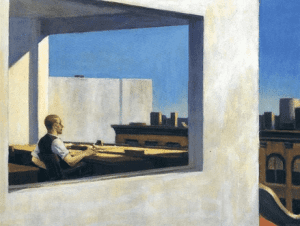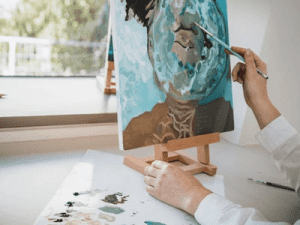(Skip to bullet points (best for students))

Born: 1890
Died: 1964
Summary of Giorgio Morandi
Giorgio Morandi was an Italian painter who lived from July 20, 1890, to June 18, 1964. He is most known for his still-life paintings of simple things like vases, bowls, flowers, and the occasional landscape. His art was also recognised for its extraordinary tonal values. He would also produce prints of his work, utilising metal sheets and scratching indents/scratches into them, then spreading ink and making prints using this process, allowing him to make and sell numerous artworks from the same original.
Morandi used dry etching to create his prints; this process required him to create dents/etching into a sheet of metal; to create darker areas, he would go over the area etching it more and more, using crosshatching; and to create light areas, he would only add a few etches again, using crosshatching; this way, less ink would get into those areas, and it would become light on the prin; To construct a print, he would apply ink to the metal sheet, allowing the ink to seep into the etches he had created, and then cover it with a sheet of paper and run it through a roller, enabling the ink to transfer into the paper.
Giorgio Morandi laboured for years in a little chamber in the heart of Italy, far from the avant-garde of his day, to solve the problems of art, the questions of modern painting, searching for the structure and order that underpins the act of representation itself. Giorgio Morandi linked the vast tradition of Italian art with 20th-century modernism with a modest selection of everyday objects and familiar landscapes painted in subdued tones and pleasant light. His works maintained a history of realistic painting while establishing a minimalist style, with meticulously constructed tonal relationships and a feeling of palpable light and space.
Morandi’s work was anchored in recognisable and universal shapes, yet his meticulous paint application and attention to a distinctive Italian quality of light implied an autobiographical aspect. Despite the fact that he painted typical domestic things, reviewers remarked on how his portrayal of these objects gave a feeling of Morandi’s personality, monastic habits, and Bolognese surroundings. His art would be important because of its thorough examination of ordinary aspects of daily life, imbuing them with profound meaning by highlighting their painterly beauty and simplicity.
Morandi seemed untouched by contemporary art movements since he was preoccupied with his own pictorial explorations at a time when the avant-garde was preoccupied with abstract painting. His concerns, however, were comparable to those of his predecessors; for example, he treated colour, line, light, space, and brushstroke as issues that needed to be answered by rigorous study and fine modifications. Morandi’s realism was more than a straightforward depiction of a topic; when comparing his paintings to pictures of the items he represented, his manipulations of volume, form, and space became obvious.
Morandi continued the tradition of Italian painting into the twentieth century by paying close attention to technique and meticulous perfection, but his minimalist style and non-narrative emphasis gave it new significance. Morandi’s still lifes had an undeniably contemporary palette, crisp lines, and precise brushstrokes, and his attention to technique and the materiality of the painted surface united succeeding painters with the epic traditions of the still life and landscape genres.
Childhood 1980-1907
Giorgio Morandi was born into a middle-class family in Bologna, Italy, as the eldest of five children. His only sibling died while he was a youngster. Morandi’s early passion in painting irritated his father, who wanted his son to join him in his export company; Morandi tried unsuccessfully to do so in 1906 before enrolling in the Bologna Academy of Fine Arts in 1907. His decision to pursue painting as a career is due in part to his father’s failure, his refusal to change his emphasis on art despite his father’s best attempts, and his mother’s confidence that her son should follow his goals.
How did Morandi use mark-making?
Morandi worked as an etcher and a painter, specialising in landscapes and still life. With distinct diagonal, vertical, and horizontal hatching in his etchings and clear broad brushstrokes of colour in his paintings, his mark language was quite different across the two opposing artforms.
Early Life 1908-1913
Despite the fact that his father died unexpectedly in 1908, leaving him to care for his mother and three younger sisters, Morandi completed his education with his mother’s help. He was originally introduced to Futurism and Cubism at this time, which inspired his early work. In his 1928 autobiography, Morandi explained that “only an understanding of the most vital achievements in painting over the past centuries could help me find my way.” He received his diploma in 1913, but he continued his studies by travelling around Italy, including to the Venice Biennale.
During World War I, Morandi’s early career was cut short when he was recruited into the Italian army. The collective army life did not suit him as a profoundly private guy. Shortly after, he suffered a nervous breakdown, which caused him to be discharged from the army quickly and compelled him to cut down his artistic production in the years that followed.
Adult Hood 1916-1943
Morandi briefly painted in the Metaphysical School style and participated in group exhibits dedicated to the movement beginning in 1916. This was the first time his art had been acknowledged on a global scale, and it is thought that this era gave him the courage to try new things. Despite his strong ties to the school’s prominent painters, like Carlo Carra and Giorgio de Chirico, he subsequently rejected the style’s impact on his subsequent work, claiming that he never painted anything he couldn’t see with his own eyes.
Morandi’s work soon evolved into the modernist style for which he is most known, with simple, quietly exquisite still lifes of ordinary household things like as bottles and jars, as well as landscapes representing his local surroundings. He created a serial approach in his still life paintings, in which he showed groupings of things with only the tiniest alterations in spacing or arrangement. While the majority of these works were paintings, Morandi frequently used etchings to depict these items in the limited black-and-white palette.
Morandi followed a peaceful, everyday routine for many years. His studio, a small room in an apartment shared with his three sisters and mother, was where he did the most of his work (he lived his whole life with his 3 unwed sisters). Despite its small size, the room was well-lit, with a view of the surrounding countryside from his window, one of two views he painted frequently. (The second setting was inspired by vistas in Grizzana, a mountain village where Morandi spent many summers with his family and where he would later establish a holiday home and studio.) The dust that collected on the various bottles and things Morandi used further crystallises his monastic lifestyle.
Despite how closely Morandi worked with Mussolini’s dictatorship in the early years, by the time World War II loomed, the artist appeared to have disassociated himself from politics and retreated into neutrality. Morandi was arrested and imprisoned for approximately a week in 1943 on suspicion of participation in resistance groups, though it’s more probable that he was apprehended as part of a broader sweep of the time’s creative figures. Following his imprisonment, the Morandi family relocated to Grizzana to avoid additional difficulties with the Bolognese authorities and to allow him to continue his work in a more tranquil environment.
Late Life 1956-1964
Many international events passed by, but Morandi remained steadfastly focused on primarily still life, honing his technique and form throughout the decades by working with a small number of identical compositions. Morandi’s intense commitment to his choice themes may be explained by the fact that he fell in love with the modest things he acquired at second-hand shops, staring and analysing their forms day and night.
The cables and antennas that were now part of the vista from his studio window began to emerge, although abstractly, in his 1950s works, reflecting the growing modernism of the world around him. Morandi remained a professor of etching at the Academy for 26 years, retiring only in 1956 to pursue art full-time as a well-known painter, ultimately financially secure from the sale of his work.
Morandi died in 1964 as a result of lung cancer. He was rarely seen without a cigarette for the most of his life, and he allegedly smoked each one all the way to the tip, narrowly missing burning his hands. In his last months, he joked in a letter, “Can you imagine that for three days I haven’t had a cigarette”
Important Giorgio Morandi Works
Natura Mortar 1914

A 1914 painting by Giorgio Morandi, depicts a wooden table on which are arranged a variety of monochrome daily items. Despite the fact that the image is abstract, the observer can recognise an upright book with its binding facing outward, which is placed in front of a transparent bottle, a vase, and a pitcher. An abstracted view of a room appears behind the table, resembling part of a wall, a window, and another table. While the items are completely inert, they are painted in such a way that they appear to be unstable and moving, with a diagonal push that drives them towards the observer.
Still Life with Yellow Cloth 1952

This still life depicts a collection of things that are both static and unsteady, and is one of a series of celebrated works created in 1952 that include the distinctive yellow fabric. He collects a number of pots around the cloth in each of these series, with only minor changes in composition and colour. He focuses our attention to the subtle effects of light, form, and colour through these little modifications, while maintaining a sense of calm and eternal stillness.
BULLET POINTED (SUMMARISED)
Best for Students and a Huge Time Saver
- Giorgio Morandi was an Italian painter who lived from July 20, 1890, to June 18, 1964.
- He is most known for his still-life paintings of simple things like vases, bowls, flowers, and the occasional landscape.
- His art was also recognised for its extraordinary tonal values.
- He would also produce prints of his work, utilising metal sheets and scratching indents/scratches into them, then spreading ink and making prints using this process, allowing him to make and sell numerous artworks from the same original.
- Morandi used dry etching to create his prints; this process required him to create dents/etching into a sheet of metal; to create darker areas, he would go over the area etching it more and more, using crosshatching; and to create light areas, he would only add a few etches again, using crosshatching; this way, less ink would get into those areas, and it would become light on the prin; To construct a print, he would apply ink to the metal sheet, allowing the ink to seep into the etches he had created, and then cover it with a sheet of paper and run it through a roller, enabling the ink to transfer into the paper.
- Giorgio Morandi laboured for years in a little chamber in the heart of Italy, far from the avant-garde of his day, to solve the problems of art, the questions of modern painting, searching for the structure and order that underpins the act of representation itself.
- Giorgio Morandi linked the vast tradition of Italian art with 20th-century modernism with a modest selection of everyday objects and familiar landscapes painted in subdued tones and pleasant light.
- His works maintained a history of realistic painting while establishing a minimalist style, with meticulously constructed tonal relationships and a feeling of palpable light and space.
- Morandi’s work was anchored in recognisable and universal shapes, yet his meticulous paint application and attention to a distinctive Italian quality of light implied an autobiographical aspect.
- Despite the fact that he painted typical domestic things, reviewers remarked on how his portrayal of these objects gave a feeling of Morandi’s personality, monastic habits, and Bolognese surroundings.
- His art would be important because of its thorough examination of ordinary aspects of daily life, imbuing them with profound meaning by highlighting their painterly beauty and simplicity.
- Morandi continued the tradition of Italian painting into the twentieth century by paying close attention to technique and meticulous perfection, but his minimalist style and non-narrative emphasis gave it new significance.
- Morandi’s still lifes had an undeniably contemporary palette, crisp lines, and precise brushstrokes, and his attention to technique and the materiality of the painted surface united succeeding painters with the epic traditions of the still life and landscape genres.
Born: 1890
Died: 1964
Information Citations
En.wikipedia.org, https://en.wikipedia.org/.
Recommend0 recommendationsPublished in Art History, Artists, Resources








Responses